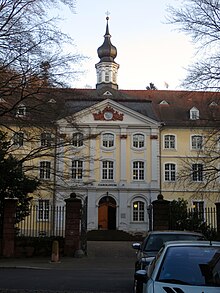Seminarium Carolinum
The Seminarium Carolinum was an Electoral Palatinate Konvikt school for Catholics in Heidelberg , which was directed by the Jesuit order .
history
At the suggestion of the Jesuits, Elector Carl Philipp decided to set up a seminar for the Catholic youth in the Electoral Palatinate . It was dedicated to St. Carl Boromäus and also bore the prince's name. It was intended to serve in particular the training of future clergy, and also the development of a general Catholic intelligentsia in the Protestant-dominated country. Many of the pupils supervised there were also enrolled students at the University of Heidelberg and are marked in the matriculations as pupils of the Seminarium Carolinum .
In 1730 the institute was opened for 20 pupils, but it grew rapidly, so that the original building - today Breitwiesersches Haus, Schlossberg 2 (formerly Jungwirthsches Haus) - soon had to be expanded. The adjacent blade gate was raised and the new upper floor building was connected to the seminar building. From 1746, Father Franz Günther SJ (1704–1788) from Bensheim was rector, before that Father Johannes Conrad Masset SJ (1683–1757) from Oestrich .
The enlarged house was soon overcrowded, too, and from 1750 onwards, Elector Karl Theodor had Franz Wilhelm Rabaliatti erect a spacious new building, which is known in Heidelberg under the name Carolinum (Seminarstrasse 2). At the laying of the foundation stone on June 8, 1750, the ruler appeared, accompanied by Duke Friedrich Michael von Zweibrücken ; Construction was completed in 1765. The laying of the foundation stone is described in detail by Johann Franz Capellini von Wickenburg , in Volume 1 of the “Thesaurus Palatinus” . According to this report, 6 different languages were taught in the school, namely German, Latin, Hebrew, Greek, French and Italian. The attached drawing should be based on the construction plan, since the new building was still unfinished when the work appeared. In 1759 Franz Bernhard von Hallberg, son of the Electoral Palatinate court chancellor Jakob Tillmann von Hallberg, was one of the pupils. Elector Karl Theodor made a foundation in 1751 for 2 theology students each from the Duchy of Palatinate-Sulzbach who were allowed to attend the seminar for 4 years free of charge and complete their studies at Heidelberg University. One of these scholarship recipients was the well-known Regensburg Bishop Georg Michael Wittmann (1760-1833) from 1778 .
The Jesuit order was dissolved in 1773 and the seminarium Carolinum initially led secular priests, from 1781 to 1802 the Lazarists continued. The former Jesuit Heinrich Kilber (1710–1783) was rector from 1774 . After Heidelberg passed over to Baden , it became a Konvikt for Catholic theology students in 1803 . From 1825 to 1842 the building was used as a madhouse, from 1844 to 1876 as an academic hospital and from 1888 as a barracks. Today it houses the administration of the university.
literature
- Peter Anselm Riedl: The buildings of the University of Heidelberg , Springer-Verlag, 2013, pp. 159–163, ISBN 3662369311 ; (Digital scan)
Web links
Individual evidence
- ^ Andreas Cser: Brief history of the city and University of Heidelberg , Lauinger Verlag, 2007, p. 148, ISBN 3765083372 ; (Detail scan)
- ^ Gustav Toepke : The register of the University of Heidelberg , 4th part, p. 333, Heidelberg, 1903; (Register page from 1760 with many students from the Seminarium Carolinum)
- ^ Website of the original seminar building, Heidelberg Schlossberg 2
- ^ Website for the Klingentor Heidelberg
- ^ Gustav Toepke: The register of the University of Heidelberg , 4th part, p. 157, Heidelberg, 1903; (Digital scan)
- ^ Hermann Wiegand: The two-peaked Musenberg: Studies on Humanism in the Kurpfalz , Verlag Regionalkultur, 2000, p. 178, ISBN 3897351374 ; (Detail scan with personal data of Father Günther)
- ^ Gustav Toepke: The register of the University of Heidelberg , 4th part, p. 131, Heidelberg, 1903; (Digital scan)
- ↑ Dominik Burkard: Oasis in an Enlightenment Addicted Time: The Catholic Theological Faculty of the University of Heidelberg between the belated Counter Reformation, Enlightenment and Church reform , Jan Thorbecke Verlag, 1995, p. 223, ISBN 3799532382 ; (Detail scan with details of Father Johannes Conrad Masset)
- ↑ Digital scan from the Thesaurus Palatinus
- ^ Gustav Toepke : The register of the University of Heidelberg , 4th part, p. 192, Heidelberg, 1903; (Digital scan)
- ^ Rupert Mittermüller: Life and work of the pious bishop M. Wittmann of Regensburg , Landshut, 1859, p. 17; (Digital scan)
- ^ Dagmar Drüll: Heidelberger Gelehrtenlexikon: 1652–1802 , Heidelberg, 1991, ISBN 3642762964 ; (Digital scan)


